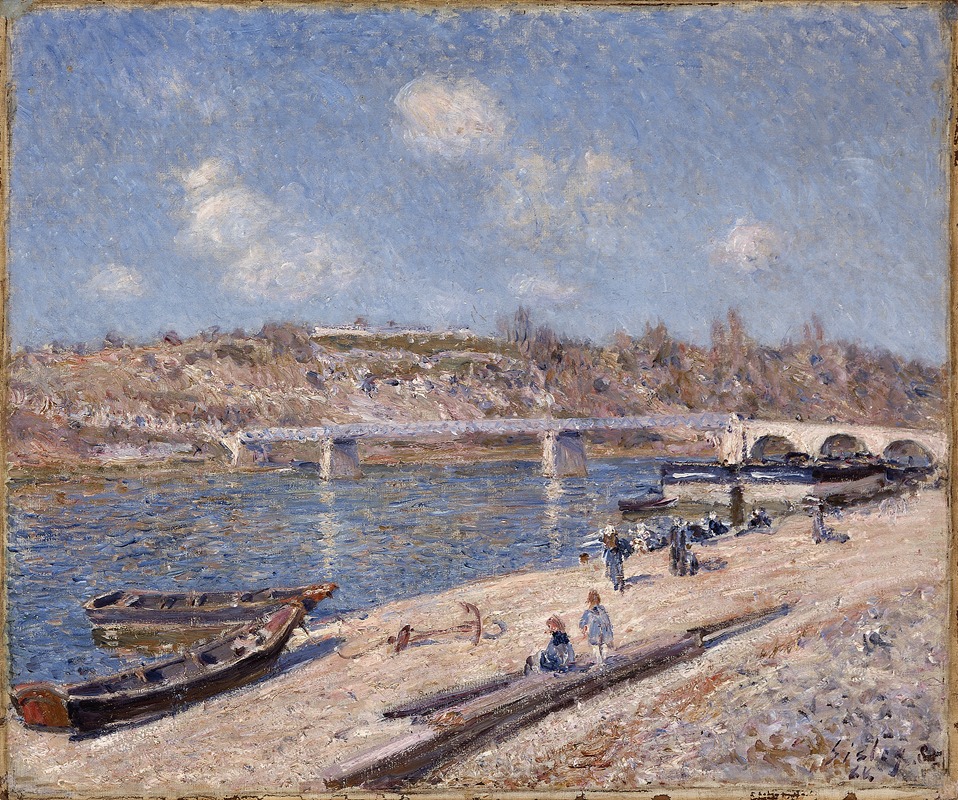
The Beach at Saint-Mammès
A hand-painted replica of Alfred Sisley’s masterpiece The Beach at Saint-Mammès, meticulously crafted by professional artists to capture the true essence of the original. Each piece is created with museum-quality canvas and rare mineral pigments, carefully painted by experienced artists with delicate brushstrokes and rich, layered colors to perfectly recreate the texture of the original artwork. Unlike machine-printed reproductions, this hand-painted version brings the painting to life, infused with the artist’s emotions and skill in every stroke. Whether for personal collection or home decoration, it instantly elevates the artistic atmosphere of any space.
"The Beach at Saint-Mammès" is an oil painting created by the French Impressionist artist Alfred Sisley in 1884. Sisley, born in Paris to British parents in 1839, was a key figure in the Impressionist movement, known for his landscape paintings that capture the natural beauty and changing light of the French countryside.
This particular painting depicts a serene riverside scene at Saint-Mammès, a small commune located at the confluence of the Seine and Loing rivers, near the town of Moret-sur-Loing in the Île-de-France region. Sisley moved to this area in the late 1870s and found inspiration in its picturesque landscapes, which he frequently painted.
"The Beach at Saint-Mammès" exemplifies Sisley's skill in rendering the effects of light and atmosphere. The painting features a tranquil beach with a few boats moored along the shore, reflecting the calm waters of the river. The composition is balanced, with the riverbank and trees on the left side of the canvas leading the viewer's eye into the distance. The sky, painted in soft blues and whites, suggests a clear, sunny day, and the light is depicted with delicate brushstrokes that capture the shimmering reflections on the water.
Sisley's use of color is subtle yet effective, with a palette dominated by blues, greens, and earthy tones that convey the natural setting. His brushwork is loose and fluid, characteristic of the Impressionist style, which aimed to capture the fleeting moments of light and atmosphere rather than precise details.
The painting is notable for its peaceful and idyllic quality, reflecting Sisley's preference for depicting the serene and harmonious aspects of nature. Unlike some of his contemporaries who often included figures in their landscapes, Sisley's focus here is primarily on the natural environment, with human presence suggested only by the boats and the distant buildings.
"The Beach at Saint-Mammès" is housed in the Musée d'Orsay in Paris, which holds an extensive collection of Impressionist and Post-Impressionist masterpieces. The museum's collection provides a comprehensive overview of Sisley's work and his contributions to the Impressionist movement.
Alfred Sisley remained dedicated to landscape painting throughout his career, and his works are celebrated for their lyrical beauty and technical mastery. Despite facing financial difficulties and relative obscurity during his lifetime, Sisley's paintings have gained recognition and appreciation in the years following his death in 1899. Today, he is regarded as one of the foremost landscape painters of the 19th century, and "The Beach at Saint-Mammès" stands as a testament to his enduring legacy in the world of art.


















